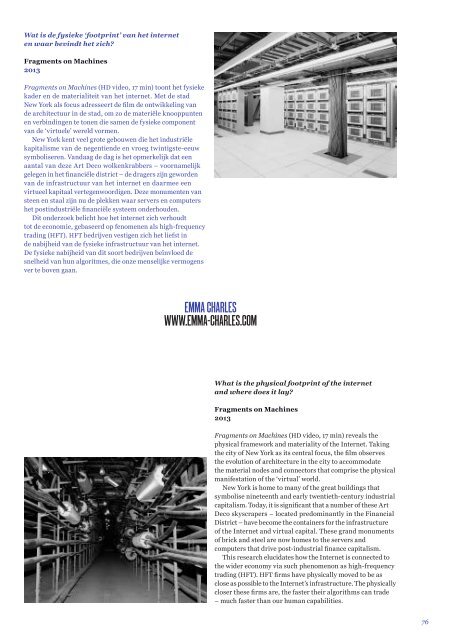THE NEXT BIG THING IS NOT A THING
Ausstellungsprojekt in Bureau Europa Maastricht Nach der "Design Anthropology" Forschung und Publikation von Yana Milev
Ausstellungsprojekt in Bureau Europa Maastricht
Nach der "Design Anthropology" Forschung und Publikation
von Yana Milev
You also want an ePaper? Increase the reach of your titles
YUMPU automatically turns print PDFs into web optimized ePapers that Google loves.
Wat is de fysieke ‘footprint’ van het internet<br />
en waar bevindt het zich?<br />
Fragments on Machines<br />
2013<br />
Fragments on Machines (HD video, 17 min) toont het fysieke<br />
kader en de materialiteit van het internet. Met de stad<br />
New York als focus adresseert de film de ontwikkeling van<br />
de architectuur in de stad, om zo de materiële knooppunten<br />
en verbindingen te tonen die samen de fysieke component<br />
van de ‘virtuele’ wereld vormen.<br />
New York kent veel grote gebouwen die het industriële<br />
kapitalisme van de negentiende en vroeg twintigste-eeuw<br />
symboliseren. Vandaag de dag is het opmerkelijk dat een<br />
aantal van deze Art Deco wolkenkrabbers – voornamelijk<br />
gelegen in het financiële district – de dragers zijn geworden<br />
van de infrastructuur van het internet en daarmee een<br />
virtueel kapitaal vertegenwoordigen. Deze monumenten van<br />
steen en staal zijn nu de plekken waar servers en computers<br />
het postindustriële financiële systeem onderhouden.<br />
Dit onderzoek belicht hoe het internet zich verhoudt<br />
tot de economie, gebaseerd op fenomenen als high-frequency<br />
trading (HFT). HFT bedrijven vestigen zich het liefst in<br />
de nabijheid van de fysieke infrastructuur van het internet.<br />
De fysieke nabijheid van dit soort bedrijven beïnvloed de<br />
snelheid van hun algoritmes, die onze menselijke vermogens<br />
ver te boven gaan.<br />
Hoe met 3D scanning een urgent verhaal kan<br />
worden verteld over verdwijnende landschappen.<br />
Frozen Relic: Arctic Works<br />
2012<br />
Het Noordpoolgebied is aan het smelten. In 2012 bereikte<br />
de ijsoppervlakte haar laagste punt sinds het begin<br />
van de metingen. Een campagne van Greenpeace, genaamd<br />
‘Save the Arctic’, vormt een baanbrekende samenwerking<br />
tussen wetenschappers, architecten en milieudeskundigen.<br />
In de zomer van 2012 nam het Greenpeace schip The Arctic<br />
Sunrise een onderzoeksteam onder leiding van de vooraanstaande<br />
wetenschapper Peter Wadhams en de in London<br />
gebaseerde ontwerpers ScanLAB naar een afgelegen gebied<br />
in de Noordpool, met als doel onze kennis van dit uniek en<br />
kwetsbaar gebied uit te breiden. Tijdens deze expeditie naar<br />
de zogeheten Fram Strait, in het noordwesten van Svalbard<br />
in Noorwegen, kon ScanLAB een enorme hoeveelheid<br />
data verzamelen en de verschillende ijsschotsen in precieze<br />
3D-scantechnologie weergeven.<br />
In totaal wisten ze 26 ijsschotsen in forensisch detail vast<br />
te leggen en hun oppervlakte nauwkeurig in kaart te brengen,<br />
om zo deze informatie te verbinden aan de 3D scans van<br />
het gebied.<br />
EMMA CHARLES<br />
WWW.EMMA-CHARLES.COM<br />
SCANLAB PROJECTS<br />
WWW.SCANLABPROJECTS.CO.UK<br />
What is the physical footprint of the internet<br />
and where does it lay?<br />
Fragments on Machines<br />
2013<br />
Fragments on Machines (HD video, 17 min) reveals the<br />
physical framework and materiality of the Internet. Taking<br />
the city of New York as its central focus, the film observes<br />
the evolution of architecture in the city to accommodate<br />
the material nodes and connectors that comprise the physical<br />
manifestation of the ‘virtual’ world.<br />
New York is home to many of the great buildings that<br />
symbolise nineteenth and early twentieth-century industrial<br />
capitalism. Today, it is significant that a number of these Art<br />
Deco skyscrapers – located predominantly in the Financial<br />
District – have become the containers for the infrastructure<br />
of the Internet and virtual capital. These grand monuments<br />
of brick and steel are now homes to the servers and<br />
computers that drive post-industrial finance capitalism.<br />
This research elucidates how the Internet is connected to<br />
the wider economy via such phenomenon as high-frequency<br />
trading (HFT). HFT firms have physically moved to be as<br />
close as possible to the Internet’s infrastructure. The physically<br />
closer these firms are, the faster their algorithms can trade<br />
– much faster than our human capabilities.<br />
How 3D scanning can tell an urgent story about<br />
disappearing landscapes.<br />
Frozen Relic: Arctic Works<br />
2012<br />
The Arctic is melting. In 2012, the summer levels of sea<br />
ice reached their lowest point since records began. The<br />
Greenpeace campaign, ‘Save the Arctic’, is a ground-breaking<br />
collaboration between scientists, architects, and environmentalists.<br />
In the summer of 2012, the Greenpeace ship,<br />
The Arctic Sunrise, took a research team headed by leading<br />
scientist Peter Wadhams and London-based designers<br />
ScanLAB to remote Arctic waters in order to deepen our<br />
understanding of the threats faced by this unique and fragile<br />
region. During this expedition to the Fram Strait, northwest<br />
of Svalbard in Norway, ScanLAB were able to capture a<br />
huge amount of data, documenting a series of ice floes using<br />
millimetre-perfect 3D scanning technology. They captured<br />
a total of 26 floes in forensic detail, mapping their surfaces<br />
precisely.<br />
76<br />
77


